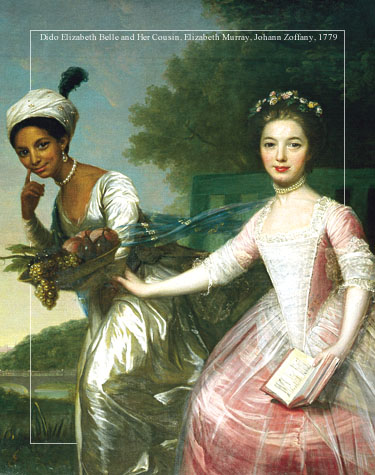
Volume VIII, Issue XVI
Belle, A Story in a Painting
The Eighteenth Century painting is intriguing! Its subjects appear to be an English noblewoman and a mysterious princess. But this is not some flight of fantasy, the women depicted are actually cousins who lived together at Kenwood House under the care of William Murray, First Earl of Mansfield. Dido Elizabeth Belle, the woman on the left, was the daughter of Captain John Lindsay, Murray's nephew, who fathered the girl when he was stationed in the West Indies. Lindsay was knighted and promoted to Admiral and left his daughter in the care of Murray in 1765. The daughter of a slave woman, she was nonetheless brought up as a free gentlewoman along with William's niece, Elizabeth Murray who is depicted on the right.
When my wife and I watched the movie Belle, which is the story of Dido and William Murray, the painting seemed familiar. It was a bit later that it came to me that that was an image my Art History professor had had on one of her slides. I've often asked fellow artists if they enjoyed Art History? They often reply that they did not, seeing it as a torturous process of memorization. They did not have the privilege of studying under Penny Griffith. She was an adjunct professor who obviously loved her material. She told us what to memorize for the test and then proceeded to weave spellbinding lectures about the story found in the art! Francisco Goya came alive as we learned his keen observations of Spanish nobility and his depiction of the darkness of war and the darkness of the human soul!
Yet the painting by Johann Zoffany, executed in 1779, remained a mystery. Perhaps it was a bit of romanticism as noblewomen might enjoy, but it would be years later that I would learn the amazing history contained in that canvas. It is the story of how Belle's relationship with William Murray led to significant advances in the fight against slavery. Belle's mother was a slave, but Belle, living at Kenmore, was accorded all the rights of a free person, including a sizable inheritance! Her great-uncle, acting in his capacity as Lord Chief Justice, made two significant rulings on the issue.
In 1772 Murray, the Earl of Mansfield, was called upon to rule in the case of an escaped slave who's owner wanted to take him back to the West Indies for sale. The Chief Justice called the slave to court. This action let it be known that the court considered him a person! Murray declared in his ruling: "The state of slavery is of such a nature, that it is incapable of being introduced on any reasons, moral or political; but only positive law, which preserves its force long after the reasons, occasion, and time itself from whence it was created, is erased from memory: it's so odious, that nothing can be suffered to support it but positive law. Whatever inconveniences, therefore, may follow from a decision, I cannot say this case is allowed or approved by the law of England."
The effect of this ruling was the recognition that English common law did not support the institution of slavery. Years before William Wilberforce campaigned to end the institution in the legislature; Murray, in his capacity as Chief Justice ruled that the institution had no basis in English law. In another case, that of the Zong massacre of 1781, he again dealt the institution of slavery a solid blow. The ship Zong, dangerously overcrowded when she left Africa with her human cargo, 442 souls in all, saw an epidemic break out among them. The slavers decided to throw one third of the slaves overboard. They then presented a claim to their insurers, arguing that they did not have enough water and needed to do so. The insurance company refused to pay.
The captain had reasoned that rather than have the slaves get sick on board and be rendered worthless, he would kill them and collect the insurance money. He would then argue that the slaves sacrificed for others when there was not enough water. It was proved beyond doubt that water was adequately available, making clear the dark intent of the slave ship captain! The UK Daily Mail writes: "Insurance was Lord Mansfield’s speciality, and he concluded that the insurers were not liable. The breathtaking brutality of the murders and the fact that drowned human beings could be reduced to an insurance claim brought home the urgency of abolishing the slave trade."




No comments:
Post a Comment